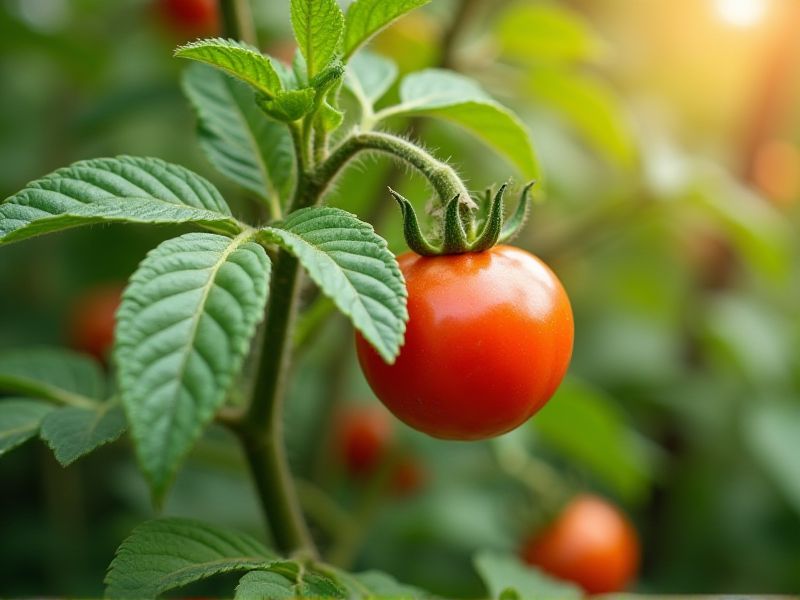
Heat-loving vegetable plants thrive in warm climates and are ideal for summer gardens. Tomatoes, known for their juicy fruits, flourish in temperatures above 70degF, making them a favorite among gardeners. Peppers, including bell and chili varieties, also prefer high heat, producing vibrant and flavorful yields when temperatures rise. Eggplants, another heat-loving plant, not only tolerate high temperatures but also contribute to a diverse array of dishes with their unique texture and flavor. If you're looking to maximize your garden's productivity during warmer months, consider planting these robust options that excel in sunny, warm conditions.
List of some Vegetables plants that love heat
- Tomato (Solanum lycopersicum)
- Eggplant (Solanum melongena)
- Bell Pepper (Capsicum annuum)
- Okra (Abelmoschus esculentus)
- Cucumber (Cucumis sativus)
- Sweet Potato (Ipomoea batatas)
- Hot Pepper (Capsicum frutescens)
- Melon (Cucumis melo)
- Zucchini (Cucurbita pepo)
- Squash (Cucurbita maxima)
Important things about Vegetables plants that love heat
Optimal Temperature Range
Vegetable plants that thrive in heat, such as tomatoes, peppers, and cucumbers, typically flourish in optimal temperature ranges of 70degF to 85degF (21degC to 29degC) during the day. Night temperatures should ideally remain above 55degF (13degC) to ensure continued growth and fruit development. These heat-loving plants not only require warmth but also benefit from well-drained soil and adequate sunlight exposure for at least 6 to 8 hours daily. Understanding these temperature preferences can significantly enhance your vegetable garden's yield and overall health.
Sunlight Requirements
Vegetable plants that thrive in heat, such as tomatoes, peppers, and eggplants, require full sun exposure to maximize their growth potential. Ideally, these plants should receive at least 6 to 8 hours of direct sunlight each day, promoting optimal photosynthesis and fruit production. In warmer climates, heat-tolerant varieties can flourish, with specific attention to adequate watering to prevent stress. For gardeners seeking robust harvests, ensuring your garden site has sunny spots can lead to healthier plants and bountiful yields.
Soil Type Preferences
Vegetable plants that thrive in heat, such as tomatoes, bell peppers, and eggplants, prefer well-draining sandy loam or loamy soil enriched with organic matter. These soil types facilitate excellent aeration and moisture retention, crucial for supporting the robust growth of heat-loving vegetables. Before planting, ensure your soil has a pH level between 6.0 and 7.0, optimizing nutrient availability for these sun-loving plants. Incorporating compost or aged manure not only improves soil structure but also boosts fertility, ensuring your vegetables receive the essential nutrients they require for healthy growth in warm conditions.
Watering Needs
Vegetable plants that thrive in warm conditions, such as tomatoes, peppers, and eggplants, require consistent moisture to support their growth during the hotter months. It is essential to water these heat-loving plants deeply and less frequently to encourage strong root development. Drip irrigation or soaker hoses can be particularly effective in delivering water directly to the root zone, reducing evaporation and minimizing fungal diseases. Consider mulching around the base of these plants to retain soil moisture and regulate temperature, ensuring optimal growth and productivity.
Pest Resistance
Vegetable plants that thrive in heat, such as peppers, tomatoes, and eggplants, can be particularly vulnerable to pests like aphids and spider mites. Implementing integrated pest management (IPM) strategies, including introducing beneficial insects like ladybugs, can help maintain healthy crops. Utilizing organic methods such as neem oil or insecticidal soap provides an effective way to combat these pests without harming the environment. Ensuring optimal growing conditions, including proper watering and mulching, strengthens your heat-loving plants, making them more resilient against infestations.
Nutrient Requirements
Vegetable plants that thrive in warm climates, like tomatoes, peppers, and eggplants, require specific nutrient inputs for optimal growth. These heat-loving plants benefit significantly from nitrogen-rich fertilizers that promote robust foliage development, while phosphorous supports strong root systems and enhances flowering. To ensure proper fruit development, adequate potassium levels are crucial, aiding in water regulation and fruit quality. Regular monitoring of soil pH and moisture levels is essential to ensure your warm-season vegetables receive the right nutrients and achieve bountiful yields.
Harvesting Time
Vegetable plants that thrive in warm climates, such as tomatoes, peppers, and eggplants, are ideal for summer harvesting. These heat-loving varieties require full sun exposure and well-drained soil to maximize their growth potential and fruit production. As temperatures rise, it's crucial to monitor soil moisture and provide adequate irrigation to prevent stress, ensuring a bountiful harvest. When you choose these resilient plants, you can enjoy vibrant vegetables packed with flavor and nutrients, perfect for your summer meals.
Companion Planting Benefits
Companion planting maximizes the benefits of growing heat-loving vegetables, such as tomatoes, peppers, and eggplants. By pairing these plants with companions like basil or marigold, you can enhance growth, deter pests, and improve flavor. For example, basil not only complements tomato plants in the garden but also helps repel harmful insects like aphids. Implementing a companion planting strategy can lead to a more vibrant and productive vegetable garden during the warm months.
Common Heat-Tolerant Varieties
Heat-tolerant vegetable varieties thrive in warm climates and extend your growing season. Consider planting heat-resistant types like 'Sun Gold' cherry tomatoes, which offer sweet flavor and abundant yields even in high temperatures. 'Cascadia' snap peas are another great option, producing crunchy pods that resist bolting when it gets hot. To enhance your garden, try incorporating heat-loving greens like 'Malabar' spinach, which flourishes in the heat while providing nutritious leaves for salads or cooking.
Seasonal Planting Strategies
Choosing heat-loving vegetable plants can significantly enhance your summer garden's productivity. Varieties such as tomatoes, peppers, and eggplants thrive in warm conditions, flourishing in temperatures ranging from 70degF to 95degF. Implementing strategic planting times ensures that these vegetables receive optimal sunlight and warmth, maximizing their growth potential. Incorporating mulch can help retain soil moisture and regulate temperature, providing an ideal environment for these sun-loving crops.
